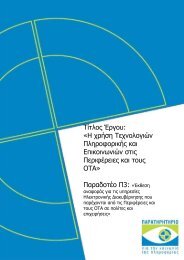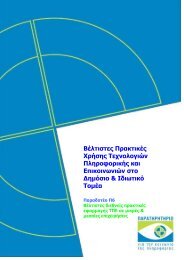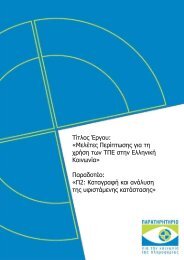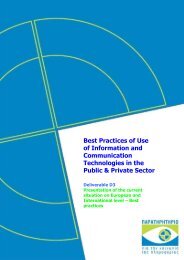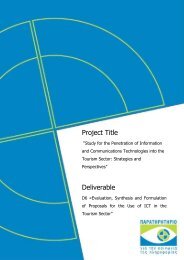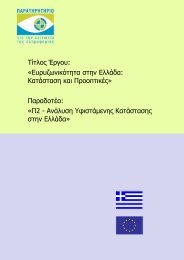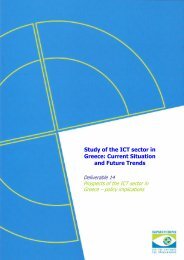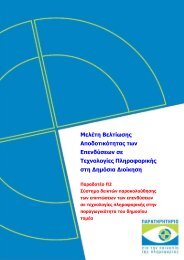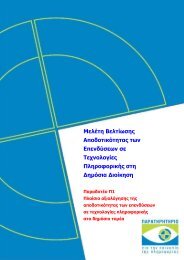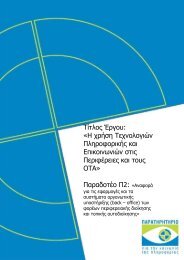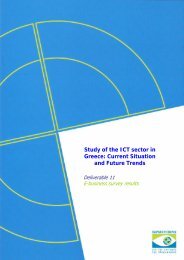Benchlearning methodology and data gathering template
Benchlearning methodology and data gathering template
Benchlearning methodology and data gathering template
- No tags were found...
You also want an ePaper? Increase the reach of your titles
YUMPU automatically turns print PDFs into web optimized ePapers that Google loves.
D.2 “<strong>Benchlearning</strong> Methodology <strong>and</strong> Data Gathering Template”1. eGEP Measurement Framework <strong>and</strong> the <strong>Benchlearning</strong> conceptBefore proceeding further, let us present a brief synthesis of the eGEP MeasurementFramework (henceforth simply eGEP MF) <strong>and</strong> how this study has led to the launch of theconcept of benchlearning.1.1. eGEP Measurement FrameworkeGEP MF is built on a very general <strong>and</strong> universalistic definition of the three-fold mission thatany public agency or programme should pursue for the delivery of public value to:o User as tax-payer: the search for efficiency gains through dynamic, productivitydriven<strong>and</strong> value for money internal operations <strong>and</strong> service provision;o User as citizen <strong>and</strong> voter: the enhancement of democracy through open,transparent, accountable, flexible, <strong>and</strong> participatory administration <strong>and</strong> policymaking;o User as consumer: the search for quality services that are inter-active, usercentred,inclusive, <strong>and</strong> maximise fulfilment <strong>and</strong> security;Correspondingly the framework is built along three value drivers :1. Efficiency;2. Democracy;3. Effectiveness;eGEP MF analytical structure is synthesised in Exhibit 1 below, where at the right end side itis initially possible to observe that all the impacts contribute to the creation of different typesof public values:1. Financial & Organisational value;2. Political Value.3. Constituency Value;Version 15
D.2 “<strong>Benchlearning</strong> Methodology <strong>and</strong> Data Gathering Template”Exhibit 1 eGEP Measurement Framework Analytical ModelEfficiencycashable financialgainsbetter empoweredemployeesbetter organisational<strong>and</strong> IT architecturesFinancial &organisational ValueDemocracyEffectivenessOpennessTransparency <strong>and</strong>accountabilityParticipationreduced admin.burdenincreased user value& satisfactionmore inclusivepublic servicesPoliticalValueConstituencyValue1.2. The concept of benchlearningWhile the concept of benchlearning existed already especially in the domain of private sectormanagement 2 , it has been proposed for the first time in a revised fashion as an instrument toadvance the underst<strong>and</strong>ing of the concrete impacts of ICT enabled public services delivery byCristiano Codagnone in the final recommendations contained in eGEP report 3 <strong>and</strong> in occasionof a major EU sponsored conference on eGovernment impact 4 .In order to further flesh out the concept of benchlearning to be applied in the course of thisstudy, it is worth briefly reconstructing the rationale leading the eGEP study to proposeeGovernment impact benchlearning exercises. eGEP has produced a comprehensive <strong>and</strong>exhaustive eGovernment measurement framework aimed at going beyond the simplemonitoring of the supply side (number <strong>and</strong> sophistication of public services online) by2 See for instance: P. V. Freytag <strong>and</strong> S. Hollensen “The process of benchmarking, benchlearning <strong>and</strong>benchaction”, The TQM Magazine, Volume 13 . Number 1 . 2001 . pp. 25-33; Karlöf, B., Lundgren, K,Edenfelt Froment, M. <strong>Benchlearning</strong> – Good Examples as a lever for development, Wiley <strong>and</strong> Sons, 20013 Cristiano Codagnone, eGEP, Measurement Framework Final Version(http://217.59.60.50/eGEP/Static/Contents/final/D.2.4_Measurement_Framework_final_version.pdf ),pp. 39-424 Cristiano Codagnone, “Bench-learning in government – reflections from eGEP experience <strong>and</strong> beyond”(http://www.egovgoodpractice.org/download.php?PHPSESSID=b2aead7a7d7734eb42e817bad57133d5&fileid=877)Version 16
D.2 “<strong>Benchlearning</strong> Methodology <strong>and</strong> Data Gathering Template”proposing indicators of concrete impacts (Full Time Equivalent Gains, Reduction ofAdministrative Burden, User Satisfaction, etc). In doing so it has proposed a number of verysophisticated indicators, which in the short term would not lend themselves to be applied in atraditional quantitative international benchmarking across EU Member States for two reasons.First of all, the main challenge is the comparability of some of the more sophisticatedimpact indicators, given the relevant peculiarities <strong>and</strong> differences existing in the publicadministrations structures <strong>and</strong> traditions of EU Member States. Second, given the novelty ofmeasuring eGovernment, many of the <strong>data</strong> needed to calculate eGEP indicators would haveto be gathered from scratch, which requires measurement capabilities not yet evenlywidespread among public agencies across Europe.Therefore, benchlearning in the field of measuring eGovernment impacts has been proposedas a short term alternative to a large scale quantitative benchmarking in order to overcomethe problem of comparability <strong>and</strong>, at the same time, to build measurement capacity from thebottom up.Given this background we can now proceed to fully define our concept of benchlearning forimpact measurement of ICT enabled services to be used in this study, which represents afurther refinement <strong>and</strong> elaboration of what was already proposed in the eGEP study. Thedefinition of the concept is as follows:A bottom-up collaborative benchmarking based on a peer-to-peer experimental exchangeamong fairly comparable public agencies from at least two different EU Member States,designed as a symmetric learning process, that with the support of experts in the role offacilitator will implement <strong>and</strong> calculate more sophisticated indicators in a chosen area ofimpact of the ICT enabled services the selected agencies provide, <strong>and</strong> in the process willbuild transformative capacities.Applying this concept to the object of this study means that the project team assembled:1) Will select two tax agencies from across EU Member States that are fairly comparableto the Greek Tax Agency in terms of the online public services delivered <strong>and</strong> of theirorganisational/ institutional context;2) In its role of facilitator will help all involved agencies gather <strong>data</strong> <strong>and</strong> calculate impactindicator(s) to compare such indicators but also to more broadly exchangeexperience;Some further considerations are in order here to better qualify the implication of thedefinition of benchlearning. First, the “peer-to-peer” <strong>and</strong> “symmetric” characterisation impliesthat there is no one best performer against which the selected agencies must becompared <strong>and</strong> from which they must learn. This distinguish our approach from howVersion 17
D.2 “<strong>Benchlearning</strong> Methodology <strong>and</strong> Data Gathering Template”benchlearning is used in the private sector where it is based on the idea of taking arecognised best performer <strong>and</strong> helping other organisation learn from it. As long as the threeagencies are comparable, the issue is not who is the best performer, but rather to joinexperiences to define <strong>and</strong> calculate an indicator that is comparable <strong>and</strong> that could later bescalable to a larger number of agencies. Second, therefore, while calculating a commonindicator of impact for the three involved agencies it is important, the focus of the study isnot the mere comparison as such but it is rather on: a) building across them the awareness<strong>and</strong> capacity to measure their ICT enabled service provision in a given area of impact; b)collaboratively test the relevance, feasibility <strong>and</strong> comparability of the chosen indicator(s) withrespect to their context specific goals, structures <strong>and</strong> processes. Third, since the experimental<strong>and</strong> collaborative measurement of the impact indicator(s) will by necessity entail an analysisof the ICT enabled services set up <strong>and</strong> delivery processes, the “learning” <strong>and</strong> the“transformative capacity building” will be not only about the measurement itself but alsoabout the what is behind the impacts actually measured, namely the key enabling <strong>and</strong>success factors or the main barriers. In synthesis our concept of benchlearning aims in thefirst place to produce organisational ‘meta-results’ <strong>and</strong> not merely at the delivery of the scorefor the impact indicator(s) calculated for each agency. These ‘meta-results’ are:o The building of sustainable organisational measurement capacity through thecollaborative implementation <strong>and</strong> calculation of impact indicator(s);o The comparative learning of key enablers <strong>and</strong> success factors <strong>and</strong> key barriersthrough the unstructured <strong>and</strong> qualitative exchange of narratives;o The establishment <strong>and</strong>/or consolidation of collaborative <strong>and</strong> exchange internationalnetwork.2. Online Tax Provision, eGEP indicators <strong>and</strong> Key PerformanceIndicators (KPI)2.1. Type of online public services <strong>and</strong> strategic impactThe EU financed research eUser, in analysing the take up of eGovernment services, hasprovided the following very useful typology of public services 5 :1) Legally enforced administrative services (paying taxes, making a declaration,applying for a license or permit) that reach in most cases the fully transactional level;2) Administration services enabling citizens to apply <strong>and</strong> obtain welfare <strong>and</strong>other kind of entitlements, that entail two way communication <strong>and</strong> that in somecases are also transactional;5eUser, Work package 5: Synthesis <strong>and</strong> Prospective Analysis (D.5.1: First Synthesised Inputs toKnowledge Repository, Including Initial Survey Results <strong>and</strong> Good Practice Examples), p. 42.Version 18
D.2 “<strong>Benchlearning</strong> Methodology <strong>and</strong> Data Gathering Template”3) Elective services that citizens may choose to use for everyday life, forimproving their access to opportunities <strong>and</strong> their participation to the public(communication about life events, enrolling in education, housing, information onjobs, education <strong>and</strong> eLearning, health related services, culture, transport,eDemocracy, open <strong>and</strong> transparent policy making). These are mostlyinformation/content services, entailing some interaction, but generally no transaction.Online public services in the first category shaped by the eUser research, have been the firstto be digitalised <strong>and</strong> made fully transactional for the simple reason that they entail a largeamount of <strong>data</strong> entry <strong>and</strong> processing work load for public administration <strong>and</strong> thus presentedthe highest potential for efficiency gains <strong>and</strong> rationalisation of work procedures. Citizenscannot improve their life chances <strong>and</strong> opportunities simply by using such services online, asthey are an obligation required by the government <strong>and</strong> not something they choose to use. Onthe other h<strong>and</strong>, probably they would expect to comply with such obligations in the easiestpossible way <strong>and</strong> at the least possible cost. Citizens benefit from such services mostlyindirectly, as long as the efficiency gains are monetised <strong>and</strong> in aggregate save their money astaxpayers.The second type of services entails mostly information <strong>and</strong> two ways interactivecommunication <strong>and</strong> some moderate level of end-to-end online transactions. They still provideefficiency <strong>and</strong> rationalisation gains for public administration, but they also ensure animportant benefit to citizen by making easier the access to their entitlement; this isparticularly important for the socially excluded, many of whom often do not even know <strong>and</strong>claim what there are entitled to.The third type of online services is the most valuable to citizens, while the direct tangibleefficiency gains for public administration in this case are marginal, <strong>and</strong> actually providing suchservices can increase overall costs. This third type of services is potentially the mostimportant for citizens as they can introduce them to better opportunities <strong>and</strong> access to lifechances, <strong>and</strong> strengthen democracy by increasing participation. Not surprisingly, thementioned eUser research found that in terms of intentions to use different levels ofeGovernment services, the potential dem<strong>and</strong> is highest for information services in allcountries in the sample. Next come communication services <strong>and</strong>, finally, transaction services,i.e. the least sophisticated services are in most dem<strong>and</strong> 6 . For these services it makes sense tolook at impact of effectiveness in terms of providing better opportunity <strong>and</strong> life chances, more6eUser, Work package 5: Synthesis <strong>and</strong> Prospective Analysis (D.5.1: First Synthesised Inputs toKnowledge Repository, Including Initial Survey Results <strong>and</strong> Good Practice Examples), p. 46Version 19
D.2 “<strong>Benchlearning</strong> Methodology <strong>and</strong> Data Gathering Template”inclusion, more openness <strong>and</strong> transparency. As they are the most evaluated by users, usersatisfaction with respect to their online provision is also a strategic impact.Online tax services fall in the first category <strong>and</strong>, thus, the most strategic area of impact isthat of efficiency. The democracy driver could also be applied (openness <strong>and</strong> transparency ofprocedures), but it is certainly less strategic. For what concerns effectiveness, the mostimportant component is “reduction of administrative burden”. User satisfaction is alsoimportant but to a lesser degree. When fulfilling government obligations, the most importantthing for citizens is to do it easily <strong>and</strong> in the least possible amount of time. If this occurs,satisfaction would be a side effect, but could never be as important as the level of satisfactionone may achieve finding a new job through an online public job searching service.So, if for reasons of feasibility <strong>and</strong> resources one must choose among the eGEP widepossibility of measurement (3 value drivers with a total of 9 sub-components <strong>and</strong> 100indicators in total), in order of priority the most strategic impact for assessing online taxprovision are those listed below <strong>and</strong> outlined in orange in exhibit 2:o Efficiency in both directly monetary <strong>and</strong> indirectly monetisable components (seelater);o Effectiveness: reduction of administrative burden;o Effectiveness : users satisfactionExhibit 2 eGEP components most relevant for tax onlne servicesEfficiencyDemocracyEffectivenesscashable financialgainsbetter empoweredemployeesbetter organisational<strong>and</strong> IT architecturesInter-institutionalcooperationOpenness <strong>and</strong>participationTransparency <strong>and</strong>accountabilityreduced admin.burdenincreased user value& satisfactionmore inclusivepublic servicesFinancial &organisational ValuePoliticalValueConstituencyValueWe can now turn to discuss further these three areas of impact <strong>and</strong> the possiblycorresponding indicators in light of the eGEP measurement framework, a final generalelement must be established.Version 110
D.2 “<strong>Benchlearning</strong> Methodology <strong>and</strong> Data Gathering Template”2.2. eGEP: relevant efficiency indicators <strong>and</strong> related metricsThe efficiency impacts considered in the eGEP model have there dimensions. The higherefficiency stemming from the offer of services online, opportunely supported by the necessaryorganisational changes, generates “Financial Value” by producing: a) directly cashable gainsfrom material cost avoidance/saving; b) gains from increased labour productivity that can bemonetized as opportunity values <strong>and</strong> that can be potentially cashed; c) gains in terms ofincreased revenue. Let us discuss each of this separately <strong>and</strong> extract the relevant indicators.► Cost avoidance/saving. Gains from material cost avoidance/saving are directlycashable, in the sense that they are immediately subtracted from the public administrationbudget <strong>and</strong> enable to maintain output delivery constant at lower costs. Typical long-hangingcash benefits are cost avoided as a result of processes dematerialisation (less paper, prints,regular mailing), of less travel needed by public agencies staff, economy of scales in usingoverhead, reduced rental <strong>and</strong> other costs related to physical locations. The Italian TaxAgency, for instance, as a result of the digitalisation of tax collection, closed down a numberof local tax offices (LTO) saving €20 million yearly in rental costs. Exhibit 3 below shows, justfor exemplificative purposes, how to calculate dematerialisation gains in the case of publiceProcurement. The same logic can be applied to any other transactional services that makeunnecessary the printing <strong>and</strong> mailing of documents to citizens or businesses.Version 111
D.2 “<strong>Benchlearning</strong> Methodology <strong>and</strong> Data Gathering Template”Exhibit 3 Measuring Dematerialisation Gains: Public eProcurementSourcesAdm in. recordsEstimate fromAdmin. RecordsTotal number of tenderspecifications issued <strong>and</strong> senteach year: XAverage Number of copies printedper tender specification: YParametersPostage cost: Kcopying cost: JEstimate fromAdmin. RecordsAverage page length of tenderspecifications: ZNon personnel costs of of paper based publicprocurementC=(X*K) + (X*Y*Z*J)Dem aterialisation gains from eProcurem entC- [(X-X1)*K] + [(X-X1)*Y*Z*J]Where X1= number of of procurement proceduresentirely completed onlineSource: eGEP Measurement Framework Compendium, op. cit, p. 31The general indicator corresponding to this type of impact that can be extracted from eGEP iso K€ saved in overhead costs (print, paper, mailing, travel, rental, electricity,etc).The sources of <strong>data</strong> for the metrics needed for the calculation of this indicator are:a. internal administrative records (comparison of relevant cost items in thebudget before <strong>and</strong> after digitalisation);b. Web metrics (needed to calculate the amount of files <strong>and</strong> cases h<strong>and</strong>leddigitally for a proxy estimation of the savings to be compared with budget<strong>data</strong>).► Gains from increased productivity. Greater gains, however, can accrue from theincreased labour productivity that the combination of reorganisation <strong>and</strong> ICT enabledproduction <strong>and</strong> delivery of public services can yield, including: task elimination (i.e. <strong>data</strong>entry), reduced processing times, reduced errors <strong>and</strong> need to re-work, less time needed forface-to-face interaction with users, additional gains from receiving <strong>data</strong> already in digitalform, etc. All of this can produce either of the two impacts listed below, both of which areexpressed with respect to an established base line:o Less hours of work are needed to perform the same amount of internal operations<strong>and</strong> provide the same amount of services (you do the same with less);o In a given time unit more output is produced with the same amount of work hours(you do more with the same)Version 112
D.2 “<strong>Benchlearning</strong> Methodology <strong>and</strong> Data Gathering Template”Accordingly the two indicators are:o K€ value of full time equivalent gains:o Increase in case h<strong>and</strong>led per processing full time equivalentThe first indicator “K€ value of full time equivalent gains” can be given a monetary value,which must be intended as an opportunity value <strong>and</strong> not already as a cash gain deriving fromreduction in budget through personnel cut. Such gain does not necessarily have to bemonetised by releasing redundant personnel, but such personnel can actually be used toproduce new <strong>and</strong> better services <strong>and</strong> thus lead to productivity gains: better <strong>and</strong> more outputwithout increasing costs.As stated, the calculation of this indicator requires a baseline of the full personnel costs ofprocessing cases in paper form, so it requires an in depth knowledge of business processes.As clearly explained <strong>and</strong> recommended in eGEP Expenditure Study Report 7 , the robustcalculation of such efficiency indicator requires the application of Activity Based Costing(Henceforth ABC). This would be a leading-edge choice for EU public administrations; ourdesk research shows that it is being adopted or recommended in countries such as the US 8 ,Australia 9 , <strong>and</strong> Brazil (in the State of Sao Paulo 10 ). ABC is relevant to measuring impact ofICT enabled public services as it will enable a more precise <strong>and</strong> robust calculation of the costof a process when is ICT enabled compared to a traditional process. This will enable thedefinition of a clear baseline against which the calculation of increased efficiency in thefollowing years will be almost automatic. All the processes, in fact will be mapped, <strong>and</strong> allactivities will be assigned a baseline cost, thus the calculation of efficiency indicators in thefollowing years will only have to input the differential <strong>data</strong>. Moreover, at the end of the zeromeasurement, agencies will be left with a new management expertise <strong>and</strong> capacity that willhelp them not only in measuring the indicators but also in analysing the overall effectiveness<strong>and</strong> efficiency of their organisational processes <strong>and</strong> take corrective actions if needed.A less sophisticated alternative to the Full Time Equivalent Gain indicator is the “TransactionCost Saving” indicator. The example for a more precise calculation of this indicator is given inexhibit 4. The difference between the offline <strong>and</strong> online overall costs of transactions, if7See eGovernment Economics Project (eGEP), Expenditure Study Final Version, 2006(http://217.59.60.50/eGEP/Static/Contents/final/D.1.3Expenditure_Study_final_version.pdf ), pp. 23-26.8 ABC is, for instance, the required cost monitoring <strong>methodology</strong> recommended by the US State of Tennessee in itsdedicated eGovernment portal http://www.state.tn.us/guidelines/pg.html .This is not surprising since the OBMCircular A-76, cited earlier, explicitly proposes the concept of Most Efficient Organisation as an agency which, amongother things, uses ABC (Executive Office Of The President Office Of Man-agement And Budget Washington, DC20503 May 29, 2003 Circular No. A-76 (Re-vised) (http://www.sba.gov/a76/circular.pdf , accessed January 2006), p.B-10.9 Australian National Audit Office (ANOVA), Measuring the Efficiency <strong>and</strong> Effectiveness of E-Government, AuditReport No.26 2004–05 (http://www.anao.gov.au/WebSite.nsf/Publications/2C3CDF64278872A9CA256FA2007F445E),Chapter 3.).10Crescia E., Measuring e-gov Impact: The experience of São Paulo, Brazil, February 2006, available athttp://web.worldbank.org/wbsite/external/topics/extinformation<strong>and</strong>communication<strong>and</strong>technologies/extedevelopment/0,,contentmdk:20797310~menupk:828158~pagepk:64020865~pipk:51164185~thesitepk:559460,00.htmlVersion 113
D.2 “<strong>Benchlearning</strong> Methodology <strong>and</strong> Data Gathering Template”positive, gives the monetary value of the efficiency gains in terms of “Full Time Equivalent ofStaff”. This still requires <strong>data</strong> on processes <strong>and</strong> personnel costs (matched by web metrics)but to a lesser degree of sophistication than in the ABC case.Exhibit 4 Calculating Transaction Cost SavingsSourcesSourcesAdmin. recordsTotal number of transactionsper year for the provision oftraditional service XTotal number of transactionsper year completed online forservice XWeb metricsAdmin. Records &Some org. analysisEstimate of full back office<strong>and</strong> front office process costsper year for the provision oftraditional service XEstimate of full back office<strong>and</strong> front office process costsper year for the onlineprovision of service XAdmin. Records &Some org. analysisSimple calculationAverage cost per transactionfor traditional service XAverage cost per transactionfor online service XSimple calculationDifference between offline <strong>and</strong>online transaction costsSUPPORTING ANALYSISWhich job tasks in the relevant departments are affected by the traditional <strong>and</strong>/or online process?How many employees <strong>and</strong> of what category are involved in the performance of the tasks required by the traditionalprocess ? How much time on average each one of them spend for the completion of his/her tasks?How many employees <strong>and</strong> of what category are involved in the performance of the tasks required by the new onlineprocess ? How much time on average each one of them spend for the completion of his/her tasks?What are the occurrence frequencies of the technical <strong>and</strong> dedicated tasks in the base year only for the traditional process?Source: eGEP Measurement Framework Compendium, op. cit, p. 31A possible shortcut to calculate the transaction cost savings from channel shift is to chooseone of the benchmarks available internationally <strong>and</strong> reported in the table below.Table 1 Benchmarks of Transaction costs savings from channel shitChannel shift cost savings Cost saving Channel comparisonCanadian Government <strong>data</strong> € 28,6 Face-to-face to webTameside MBC (2004/05) € 20,9 Face-to-face to webTameside MBC (2004/05) € 1,7 Telephone to webGiga (market research) € 7,3 Telephone to webForrester (market research) € 24,3 Telephone to webMcKinsey (market research) € 5,6 Telephone to webAverage channel shift cost savings € 24,8 Face-to-face to webAverage channel shift cost savings € 9,7 Telephone to webSource: Publicly available evidence (web search)Using one of this benchmarks in combination with web metrics <strong>data</strong> on the number oftransactions completed online, one could produce a first proxy of the overall potential FullTime Equivalent gains achieved. To increase its robustness, one would also have to controlVersion 114
D.2 “<strong>Benchlearning</strong> Methodology <strong>and</strong> Data Gathering Template”that transactions using other channels have decreased. This is a much more feasibleapproach but naturally not as accurate as the one illustrated earlier.The second indicator “Increase in case h<strong>and</strong>led per processing full time equivalent” is truly anindicator of productivity that can be simply given a volume measurement. This is, actually, acombined efficiency-effectiveness impact as it implies faster processing times <strong>and</strong> more orbetter services, <strong>and</strong> thus should result in reduced waiting times <strong>and</strong> better delivery for thecitizens <strong>and</strong> businesses. The calculation of this indicator can be done only with the detailed<strong>data</strong> that can be provided by the application of the ABC method.► Increased revenues. Improved efficiency through a faster <strong>and</strong> cheaper analysis ofcitizens’ <strong>and</strong> firms’ <strong>data</strong> can bring up a part of the submerged economy, fight tax evasion <strong>and</strong>generate new tax revenues. This is exactly what happened in Italy, although with a lag timeof 4-5 years, since when the digitalization of services <strong>and</strong> processes became fully operationalin 2001: for the first time in years, the revenue collection for 2006 have substantiallyincreased. The relevant indicator from the eGEP framework is:o “K€ increase in revenue collected from enlarged coverage”The <strong>data</strong> for this indicator should be easy to recover from internal administrative records, butgiven the time lag it is difficult to apply such indicator in a short one-shot benchlearningexercise, as a longitudinal analysis of <strong>data</strong> would be necessary to identify the increase inrevenues <strong>and</strong> correctly attribute it only to the digitalisation of processes. Moreover, such gainoccurs not simply if tax services are offered online but also if ICTs are pervasively used in theback-office <strong>and</strong> for <strong>data</strong> mining purposes. As a summary of the discussion the table belowpresents the indicators of monetisable efficiency relevant for the measurement of impacts ofonline tax services.Table 2 Indicators for monetisable efficiencyType of gainIndicator (s)Cost avoidance K€ saved in overhead costs (print, paper, mailing, travel, rental)Increased productivity - K€ value of full time equivalent gains;- Increase in case h<strong>and</strong>led per processing full time equivalentIncreased revenues K€ increase in revenue collected from enlarged coverageIn concluding this section on efficiency two contrasting considerations can be made. On theone h<strong>and</strong>, the indicators of efficiency discussed above are included, in some form or another,in all major national <strong>and</strong> international eGovernment measurement methodologies adoptedfrom 2002 onwards in Europe, USA, Canada, Australia. On the other h<strong>and</strong>, reliable <strong>and</strong> steadycalculated results are still scant. More so for the European context (with the exclusion of theUK case) <strong>and</strong> less for Australia, the US <strong>and</strong>, as seen, increasingly Brazil, where moreVersion 115
D.2 “<strong>Benchlearning</strong> Methodology <strong>and</strong> Data Gathering Template”sophisticated techniques area being applied. The reasons for this lag are two. First, theprocess of <strong>data</strong> <strong>gathering</strong> <strong>and</strong> indicators construction, especially the first time when the zeromeasurementis produced, can be fairly challenging. Second, results of such measurementmight be politically sensitive to communicate externally, as well as internally. This is linked tothe fact that the actual realisation of such gain is often thought as automatically leading topersonnel cuts, which in some countries is not possible without introducing reforms to thepublic sector labour market regulation. While the second reason is difficult to impact,benchlearning projects can start impacting the first, even when they produce proxyindicators.2.3. eGEP: relevant effectiveness indicators <strong>and</strong> related metrics► Reduction of administrative burden (AB). The traditional definition of AB forbusinesses <strong>and</strong> citizens is as follows: Administrative burdens are the costs to the businesses<strong>and</strong> individuals of complying with the information obligations resulting from Governmentimposedlegislation <strong>and</strong> regulations. It includes both compliance with obligations <strong>and</strong> theexercise of rights <strong>and</strong> the application for public servicesThis area of impact , in general <strong>and</strong> not specifically on ICT enabled public services, is onewhere a lot of advancement has been made in terms of measurement, especially for whatconcern reduction of burden for businesses. On the wake of an initiative launched by theOECD, a community network working on the measurement <strong>and</strong> reduction of theadministrative burden for businesses has emerged 11 <strong>and</strong> various publications have beenreleased. Among these we can cite the international manual on the use of the St<strong>and</strong>ard CostModel to measure <strong>and</strong> reduce the administrative burden 12 .Also the European Union has been pointing out the importance to reduce the administrativeburden. One of the most recent initiatives of the European Commission, the Communicationon a strategy for the simplification of regulatory environment 13 , sets the strategy foradministrative simplification at the EU level, dem<strong>and</strong>ing to Member States to implement theidentified initiatives in the various fields within their territories through National ReformProgrammes (NRP). As a direct follow-up of this Communication, the First progress report onits implementation 14 inserts, among the national initiatives included, administrative costsreduction <strong>and</strong> adoption of eGovernment <strong>and</strong> ICT solutions.11 http://www.administrative-burdens.com/12 St<strong>and</strong>ard Cost Model Network, International St<strong>and</strong>ard Cost Model Manual: Measuring <strong>and</strong> Reducing AdministrativeBurden for Businesses (http://www.oecd.org/<strong>data</strong>oecd/32/54/34227698.pdf)13 COM/2005/0535 final14 European Commission, First Progress Report on the strategy for the simplification of the regulatory environment,Brussels, November 2006, available at http://ec.europa.eu/enterprise/regulation/better_regulation/docs/en_690.pdf,(accessed December 2006)Version 116
D.2 “<strong>Benchlearning</strong> Methodology <strong>and</strong> Data Gathering Template”Exhibit 3 overleaf clearly explains what the administrative burden is <strong>and</strong> how it differs fromother components of burden imposed by government through regulation..Exhibit 5 Defining Administrative BurdenCost ofregulationDirect financialcosts (licensefees)CompliancecostsLong termstructural costsIndirect financialcosts (installing afilter)•Costi Administrative amministrativi:costs:Send documentationAs anticipated, the most widespread method to measure administrative burden <strong>and</strong> itsreduction is the St<strong>and</strong>ard Cost Model. Businesses <strong>and</strong> individuals are confronted withnumerous rules <strong>and</strong> regulations imposed by the Government (central Government, joint-Governments, regulatory company bodies). Complying with these rules <strong>and</strong> regulationsusually involves costs, which can be divided into various different categories or cost drivers(reporting, labelling, research, planning, maintaining). The St<strong>and</strong>ard Cost Model is aquantitative <strong>methodology</strong> that can be applied in all countries. It was developed <strong>and</strong>implemented in the Netherl<strong>and</strong>s, Denmark, Norway <strong>and</strong> Sweden <strong>and</strong> was compiled by aninternational working group on administrative burdens consisting of Denmark, Sweden,Norway, Belgium, the UK <strong>and</strong> the Netherl<strong>and</strong>s. The Netherl<strong>and</strong>s is a forerunner in Europe interms of the quantitative measurement <strong>and</strong> monitoring of the development of administrativeburdens. The <strong>methodology</strong> to quantify administrative burdens that was developed - the socalledst<strong>and</strong>ard cost model (SCM) - identified the dem<strong>and</strong>s in legislation <strong>and</strong> puts a price tagon these dem<strong>and</strong>s consisting of time <strong>and</strong> money spent to fulfil the requirements, as shownbelowAB= T*Q*F*PWhere:T= time spent on information obligations;Q= number of citizens / businesses;F = yearly frequency of complying with information obligationsP = Tariff per hour (straightforward for businesses, more difficult for citizens)Version 117
D.2 “<strong>Benchlearning</strong> Methodology <strong>and</strong> Data Gathering Template”To quantify the administrative burden, also known as ‘red tape effect’, the time normallyspent on fulfilling an individual information requirement is valued at the going labour costsrates (tariff). This shows how much the individual information requirement costs (P = time xtariff). By multiplying the price with the frequency of the information obligation (e.g. monthly,annually) <strong>and</strong> the amount of company’s involved (Q) the total burden is calculated. Withinthis <strong>methodology</strong> the administrative costs are identified at a detailed level of individualinformation dem<strong>and</strong>s <strong>and</strong> their price. As already anticipated in the introduction, in 2005 theLegislative Burden Department of the Dutch Ministry of Finance analysed that the top 100obligations with the most severe administrative burden in the Netherl<strong>and</strong>s amount up to€17.7 billion, or 3.7% of GDP.The SCM, however, is a method to measure <strong>and</strong> reduce the AB in general <strong>and</strong> does not singleout the effect of ICT supported work <strong>and</strong> delivery per se. We know, however, thatadministrative simplification is increasingly driven by ICT, both in the internal production <strong>and</strong>in the external delivery of services. Simplified forms (with less <strong>data</strong> fields), not asking thesame information twice, pre-populated e-forms, e-dossier, one stop shop portals forbusinesses, these are all ICT enabled applications that cant substantially reduce the AB, evenwithout changing regulation. In this respect, the Netherl<strong>and</strong>s are again a forerunner, since atthe end of 2005 the Dutch Ministry of the Interior introduced a new method to measure ABthat has the potential to identify the impact of ICT per se. This method is “the multiple use ofinformation monitor” (henceforth simply Monitor) 15 . Monitor’s primary goal is to assess thereduction in the amount of information requested by government organisations from citizens<strong>and</strong> businesses. It measures the information dem<strong>and</strong> of the public sector, <strong>and</strong> how this haschanged over time. It also reveals to what extent the deployment of ICT helps to reduce theadministrative burden <strong>and</strong> improves services to citizens <strong>and</strong> businesses. One importantadvantage of this <strong>methodology</strong> is its practical nature, as its focus is on government servicesrequested or completed (transaction) by means of a form. By taking the informationrequested on the forms as a starting point (baseline), this method does not constitute arelevant additional burden for the government organisations assessed. In fact, it is enoughthat they provide evaluators access to the online forms <strong>and</strong> then they can evaluate theamount of information requested <strong>and</strong> whether is less than in the case of paper based services<strong>and</strong> over time. This also makes it easier to apply in international comparisons <strong>and</strong> eventuallyin benchmarking. Concretely the method categorises <strong>and</strong> counts <strong>data</strong> fields on forms.15 Dutch Ministry of Interior <strong>and</strong> Kingdom Relations (2006). MONITOR. Multiple Use of Information, documentobtained from John Koostra of the Dutch Ministry of Interior <strong>and</strong> Kingdom Relations. This <strong>methodology</strong> was alsopresented by Mr. Keuzenkamp of the Dutch Ministry of Interior <strong>and</strong> Kingdom Relations at eGEP final conference(Vienna 8 February 2006). The quite synthetic <strong>and</strong> very clear report illustrating in English the principle <strong>and</strong> practicalimplementation of this <strong>methodology</strong> can be downloaded athttp://www.minbzk.nl/contents/pages/65347/monitor.pdf.Version 118
D.2 “<strong>Benchlearning</strong> Methodology <strong>and</strong> Data Gathering Template”Currently Cristiano Codagnone, in collaboration with Capgemini, is developing an enhancedversion of this method, which is only at its piloting stage. This enhanced method wouldmeasure the time needed to fill in the form. The formula would then be for a specific servicedelivery process:[nr of <strong>data</strong>-fields 16 an applicant must fill in] * [the frequency of the interaction] *[a st<strong>and</strong>ard cost per time unit].The important difference with the SCM is that the outcome of the measurement will not bemeasured for all costs drivers but only for the information requirement. Moreover, animportant advantage is that when applied to a well defined service or set of services, theeffort needed will be limited <strong>and</strong> the outcome could be comparable even at an EU25 level.Finally, whereas the SCM needs external <strong>data</strong> <strong>gathering</strong> by way’s of interviews, surveys, focusgroups, the enhanced re-use of information method can produce measurement indicatorswith only little efforts on the side of the public agencies participating to a benchlearning pilot<strong>and</strong> eventually, through the lessons learnt from such pilot, a measurement could be entirelybe produced without any efforts on the side of the public agencies.All the discussion above must be integrated by a major caveat: whereas it is easy to give amonetary value to the time saved by business (using an average tariff per hour of the cost ofpersonnel), the same does not apply to citizens, as the monetary value of their time is moredifficult to be given a monetary value.For administrative burden reduction the eGEP relevant indicators are:o Amount of time saved by citizenso Value of material costs saved by citizen (transportation, mailing, payingprofessional intermediaries)o K€ value of time saved to businesseso Value of material costs saved by businesses (transportation, mailing,paying professional intermediaries)The calculation of the indicators focussing on time, requires the comparative application ofthe St<strong>and</strong>ard Cost Model method first to calculate the time (valorised for businesses) neededto comply (in our case to file taxes) using the traditional delivery <strong>and</strong> then to calculate thetime (valorised for businesses) using the online delivery. The difference between these twocalculations is the net impact in terms of reduction of administrative burden.Data for such <strong>methodology</strong> come from three sources: a) knowledge of administrativeprocedures to quantify the frequency of the obligation; b) statistics <strong>and</strong> consolidatedbenchmark for the valorisation of time; c) interviews with citizens <strong>and</strong> businesses to have a16 Per category: for example Basic fields applying to all applicants, Situational field, Compulsory field, Non compulsoryfield on the form(s).Version 119
D.2 “<strong>Benchlearning</strong> Methodology <strong>and</strong> Data Gathering Template”direct estimate of the time required, or in alternative d) simulation by the evaluators tocalculate the time.When considering time savings, one has to distinguish between two kinds. The first is strictlyrelated to the time of filling in the form. The second is related to the time needed to go to atax office <strong>and</strong> present the form. In respect to the first kind of time saving, the <strong>methodology</strong>currently under development by Codagnone <strong>and</strong> based on the verification of amount of <strong>data</strong>requested in online forms, is a possibility for using source (d) in alternative to directinterviews. Evidently, however, the results can be very large or null, depending on how thedigitalisation has been produced. In the extreme case of success if online forms are prepopulatedby the public administration <strong>and</strong> users have only to change a few field or simplyvalidate <strong>and</strong> send them, the impact is maximum as the time required to users is almost zero.If online delivery amounted simply to the digitalisation of paper forms, the time saving inactually filling the forms will be almost non existent, <strong>and</strong> the real saving will only amount tothe fact that users do not need to go to local tax offices.Material costs saving (for transportation, mailing, paying a professional intermediary) can begained again either through interviews or thorough evaluators simulation <strong>and</strong>/or estimation.Evidently the cost of paying professional intermediaries is saved in as much as thedigitalisation of tax services have also entailed a simplification. Otherwise users will still haveto pay advisors to underst<strong>and</strong> what to fill in <strong>and</strong> then return online the tax forms.So in general the results of this indicator can vary greatly depending on the business modeladopted for the delivery of online tax services in the various countries.► Users satisfaction. There are two dimensions of user satisfaction con<strong>template</strong>d in theeGEP model, one is deemed “unobservable <strong>and</strong> subjective” the other “observable <strong>and</strong>objective”.The first is the user satisfaction that is explored through users surveys, asking citizens <strong>and</strong>/orbusinesses if they are satisfied with a particular service. It is subjective in as much asrespondents provide answers not just after using the services <strong>and</strong> such answers may oftenreflect either expectations or prejudices, <strong>and</strong> not necessarily a fair assessment of the service.While this method is quite widespread, the eGEP study has illustrated the limits of thisapproach 17 . Such limits have actually led to the proposal of applying the Mystery UserMethodology for the Greek case.Apart from such methodological limits, the users’ satisfaction survey source is not applicableto a short-time benchlearning exercise for simple practical reason. The three institutionsinvolved in the benchlearning may each have their own survey <strong>data</strong> (but we know that this is17 See eGEP, Measurement Framework Compendium, op. cit, pp. 35-43Version 120
D.2 “<strong>Benchlearning</strong> Methodology <strong>and</strong> Data Gathering Template”not the case for the Greek Tax Agency 18 ), but the <strong>data</strong> of these surveys would not becomparable, as they would be based on different methodologies <strong>and</strong> questions. On the otherh<strong>and</strong>, conducting a common survey for the three cases would require more time <strong>and</strong>resources than those available for this project.In practice there are two ways to measure the quality, <strong>and</strong> consequently the satisfactionusers may derive from services:1. Directly asking users through a survey of the general public (subjective);2. Indirectly evaluating the quality of the outcomes of the services assuming that thiswill increase satisfaction (objective).In the case of administratively enforced transactional services, from which users cannot gainbenefits, other than simply comply <strong>and</strong> forget about it, the most evident <strong>and</strong> objective qualityoutcome is the reduction in waiting times to receive the final clearance that they havesuccessfully complied with the obligation. Accordingly, the indicator from those proposed byeGEP that is more relevant for tax services can take two forms that are variation around thesame issue:o Reduction in the time needed to receive tax clearance;o Reduction in the time needed to receive tax refunds (whenapplicable). As a summary of the discussion the table below presents the indicators of monetisableefficiency relevant for the measurement of impacts of online tax services.Table 3 Indicators for effectivenessType of gainIndicator(s)Reduction of- Amount of time saved by citizensAdministrative burden - Value of material costs saved by citizen- K€ value of time saved to businesses- Value of material costs saved by businessesUsers satisfaction - Reduction in the time needed to receive tax clearance;- Reduction in the time needed to receive tax refundsThe <strong>data</strong> for these indicators should be readily available from internal administrative records.Besides this indicator, there are other possible ways to indirectly measure quality <strong>and</strong>satisfaction that we discuss below, although they will not be applied to our benchlearningstudy as they require sophisticated web analytics software that are not in use at GSIS. Wediscuss them as possibility for future use <strong>and</strong> as producing <strong>data</strong> that should be included in thegeneral system of Key Performance Indicators discussed in par. 1.4.These alternative ways are based on the increasingly <strong>and</strong> sophisticated use of metrics takenfrom web analytics, as an indirect measure of users satisfaction, on the basis of the18 General Secretariat for Information Systems (GSIS)Version 121
D.2 “<strong>Benchlearning</strong> Methodology <strong>and</strong> Data Gathering Template”assumption that repeated usage <strong>and</strong> especially cross-usage (equivalent of cross-selling in amarket context), namely users that after using service X come back <strong>and</strong> use service Y,indicate the equivalent of what in a market context is considered the customer loyalty <strong>and</strong>fidelisation springing from the quality of the services provided. Indeed, web trackingmethodologies can provide very rich <strong>data</strong> on traffic patterns, users’ behaviour, <strong>and</strong> siteperformance by using so called “clickstream” (<strong>data</strong> left by web users), visitor log files, <strong>and</strong>server <strong>data</strong>. A combined use of such <strong>data</strong> can produce the following kinds of individual-level<strong>data</strong>:o Number of visitors that see a particular pageo Number of users during off-hours (Saturday, Sunday, or after 8 p.m. as this showthat the 24/7 availability provide convenience of use)o Percent of visitors who click on a particular linko Where visitors click nexto Time required to load pages (slow page delivery)o Number of repeat visitorso Number of unique visitorso Average time spent on any one pageo Exit rate, or how fast users move off siteUsing such approach, it is possible to measure impacts in terms of satisfaction <strong>and</strong> citizencentricity in a fairly manageable, feasible <strong>and</strong> comparable way. The eGEP indicators coveringthis new area are:o Increase in number of unique users repeatedly using online serviceso Increase in number of unique users cross-using serviceso In off-hours service usage/info downloadso Improvement in technical performances of online applications (page loadtime)o Decrease in exit rates (number of users who start <strong>and</strong> then ab<strong>and</strong>on aservice)If a sophisticated web analytic software is used all this <strong>data</strong> are generated periodically,consistently <strong>and</strong> at no personnel cost, except that of summarising <strong>and</strong> elaborating such <strong>data</strong>.2.4. General KPI system for tax online provisionA Key Performance Indicator (KPI) tableau du bord for the provision of online delivery of taxservices is something different from an Impact Measurement System, in the sense that itVersion 122
D.2 “<strong>Benchlearning</strong> Methodology <strong>and</strong> Data Gathering Template”includes also indicators of performance that are not in themselves an impact, such as, forinstance, supply side <strong>and</strong> take up parameters.In this paragraph, in light of the discussion above <strong>and</strong> of the results of deliverable D.4 (deskresearch report on tax online service in EU25), we present what we consider a list of KPIsthat should be used for online tax delivery. This list is prescriptive, in the sense of ‘whatshould be’, regardless of what is available <strong>and</strong> feasible. In this sense it is worth stressing thatthis KPIs list is not related to the indicators that will be actually used for the benchlearningcases as these are selected in light of the availability of <strong>data</strong> from GSIS (see next section).In structuring such list we have included some of the indicators above into the takecategories.Supply side1. Number of services available online2. Services Score on the CapGemini Online sophistication index (1=information only; 2=download of forms; 3= two ways interaction; 4= transaction; 5= citizen centricity.)Dem<strong>and</strong> side / take up3. Total number of citizens/ businesses submitting taxes online;4. Number of unique users;5. Number of registered users;4. Number of users using more than one service;5. Amount of usage during off-hours.Comment. Indicator number 3 is the key one for the dem<strong>and</strong> side, as an internal benchmarka tax agency should consider for the use of eGovernment services in general by thepopulation. According to the last available <strong>data</strong> produced by the Observatory for the GreekInformation Society, only 3% of citizens in the relevant age group used eGovernmenttransactional services in 2006 19 . Given the importance of tax services, take up of tax onlineservices should be at least 3% of the relevant population group (15-64). From the <strong>data</strong> wehave on individual tax forms (E1), for instance, take up was 5.6% in 2006 (399.000 formssubmitted online divided by the population in age group 15-64). Considering that totalInternet penetration in Greece in 2006 was 26.5%, according to the <strong>data</strong> provided by theGreek Observatory, the relative take up ratio of tax online services among Internet users is21.1% (5.6% divided by 26.5%). This normalised figure can be used for internationalcomparison. In Italy, for instance, 2 million users directly submit tax forms online, whichamount also to 5% of the relevant population (15-64), but because the Internet penetration19 The annual measurement of the eEurope <strong>and</strong> i2010 indicators conducted by the Observatory for the GreekInformation Society, p. 3Version 123
D.2 “<strong>Benchlearning</strong> Methodology <strong>and</strong> Data Gathering Template”is higher than in Greece (35%), the relative take up ratio of tax online services is only about14%. On the other h<strong>and</strong>, a consideration hinting at the difficulty of comparison, this figurecannot be taken as the real comparison, because in the Italian model a lot of forms aresubmitted online by intermediaries on behalf of citizens.Technical/Usability performance6. Page load times;7. Decrease in exit rates (number of users who start <strong>and</strong> then ab<strong>and</strong>on a service);8. Overall usability score (to be assessed through usability tests);Efficiency Impact9. K€ saved in overhead costs (print, paper, mailing, travel, rental, electricity, etc);10.K€ value of full time equivalent gains;11. Increase in case h<strong>and</strong>led per processing full time equivalent;12. K€ increase in revenue collected from enlarged coverage.Effectiveness Impact13. Amount of <strong>data</strong> fields requested to fill in for online forms;14. Number of online services for which pre-populated forms are available;15. Amount of time saved by citizens;16. Value of material costs saved by citizen (transportation, mailing, paying professionalintermediaries);17. K€ value of time saved to businesses;18 Value of material costs saved by businesses (transportation, mailing, paying professionalintermediaries);19. Reduction in the time needed to receive tax clearance;20. Reduction in the time needed to receive tax refunds (when applicable).Comment. Indicator 13 <strong>and</strong> 14 are instrumental for indicators 15 <strong>and</strong> 17.In next page table 4 presents a synoptic summary of the above KPIsVersion 124
D.2 “<strong>Benchlearning</strong> Methodology <strong>and</strong> Data Gathering Template”Table 4 Complete list of KPIs for tax online serviceDimensionsIndicator (s)Supply side1. Number of services available online2. Services Score on the CapGemini Online sophistication indexDem<strong>and</strong> side (take up) 3. Total number of citizens/ businesses submitting taxes online4. Number of unique users5. Number of registered users4. Number of users using more than one service5. Amount of usage during off-hoursTechnical performance 6. Page load times7. Decrease in exit rates (number of users who start <strong>and</strong> thenab<strong>and</strong>on a service)8. Overall usability score (to be assessed through usability tests)Efficiency impacts 9. K€ saved in overhead costs (print, paper, mailing, travel, rental,electricity, etc)10.K€ value of full time equivalent gains11. Increase in case h<strong>and</strong>led per processing full time equivalent12. K€ increase in revenue collected from enlarged coverage.Effectiveness impacts 13. Amount of <strong>data</strong> fields requested to fill in for online forms14. Number of online services for which pre-populated forms areavailable15. Amount of time saved by citizens16. Value of material costs saved by citizen (transportation,mailing, paying professional intermediaries)17. K€ value of time saved to businesses18 Value of material costs saved by businesses (transportation,mailing, paying professional intermediaries)19. Reduction in the time needed to receive tax clearance20. Reduction in the time needed to receive tax refunds (whenapplicable)Version 125
D.2 “<strong>Benchlearning</strong> Methodology <strong>and</strong> Data Gathering Template”3. Indicators selected for <strong>Benchlearning</strong> cases3.1. Key findings from D.1The findings of D.1 provide the framework of feasibility for the selection of the indicators tobe considered in benchlearning.First, consolidated historical <strong>data</strong> area available for individual tax form (E1) <strong>and</strong> VATdeclarations, which are also internationally the two most used online tax services <strong>and</strong>,therefore, are selected as the focus of analysis for the calculation of the indicators.Second, because of difficulties in finding the more detailed <strong>data</strong> needed to calculate the “ FullTime Equivalent gain” indicator, for the efficiency value driver, a proxy indicator will becalculated (see infra).Third, lack of <strong>data</strong> on the structure of costs will not allow calculating the efficiency indicatorof saving in overhead costs. Same applies for indicator about increased revenues.Fourth, <strong>and</strong> moving to the effectiveness value driver, <strong>data</strong> are available to consider reductionof waiting times for tax clearance.Fifth, a proxy calculation of the reduction of administrative burden for citizens <strong>and</strong> businesswill be possible.Sixth, since no <strong>data</strong> on users satisfaction surveys are available no indicator of subjective usersatisfaction will be calculated in the benchlearning exercise. Naturally, only for the Greekcase, insights on this topic will come out of the Mystery User Methodology implementation.3.2. Selected Feasible IndicatorsSo, in light of the six facts above, given the <strong>data</strong> that GSIS is capable of pulling out, thefollowing are the indicators that appear feasible to calculate <strong>and</strong> with a minimum of relevance<strong>and</strong> comparability values:Efficiency Value Driver:‣ Proxy estimate of Full Time Equivalent Gain in the form of: opportunity monetaryvalue of the time saved for <strong>data</strong> entry by LTOs employees in the Greek case, <strong>and</strong> bythe comparable equivalent for the two international cases.Effectiveness Value Driver:‣ Reduction of waiting times for citizens <strong>and</strong> businesses to receive tax clearance in theGreek case <strong>and</strong> for a comparable equivalent for the International cases;‣ Time <strong>and</strong> other resources (transportation, mailing, paying intermediaries) saved bycitizens <strong>and</strong> businesses through online submission (same for all cases), in short“Reduction of administrative burden”.Version 126
D.2 “<strong>Benchlearning</strong> Methodology <strong>and</strong> Data Gathering Template”3.3. Other issues to be explored for the international casesFor the Greek case <strong>and</strong> for the two international cases the <strong>data</strong> needed to calculate thesethree indicators will be gathered <strong>and</strong> the indicators calculated (see next section on thecalculation).In addition to this, for the two international cases information will be sought also on: a)background <strong>and</strong> various areas addressed in the D.1 for the Greek case; b) possiblyinformation on other indicators already calculated within the two cases.This is reflected in the differences of the <strong>data</strong> <strong>gathering</strong> <strong>template</strong>s for the international cases,which include an initial part on background, one on the existence of already runningmeasurement system <strong>and</strong> on possible indicators already calculated, <strong>and</strong> one on the selectedindicators for the bench-learning exercise.4. Metrics <strong>and</strong> calculation for selected indicatorsThe metrics <strong>and</strong> calculation of the indicators should be already clear from the discussion insection 1, <strong>and</strong> below we provide simple operational guidelines.4.1. Metrics <strong>and</strong> calculation for efficiency indicatorTable 5 Metrics <strong>and</strong> sources for efficiency indicatorMetricTime needed for <strong>data</strong> entry by employees when receivingforms in paper formNumber of forms received online each yearAverage per hour cost of employees involved in <strong>data</strong> entySourceExtrapolation frominterviewsWeb metricsInternal administrativerecordCalculation procedure:1. Establish an average time needed for <strong>data</strong> entry;2. Verify that it can be assumed that when forms are submitted online, <strong>data</strong> entry time= zero;3. Multiply average <strong>data</strong> entry time by the numbers of forms submitted online = timesaved by employees (if possible year by year);4. Calculate the average per hour cost of employees involved in <strong>data</strong> entry;5. Multiply the time saved (calculated in step 3) by the average established in step 4=opportunity monetary value of the <strong>data</strong> entry time saved by employees.Version 127
D.2 “<strong>Benchlearning</strong> Methodology <strong>and</strong> Data Gathering Template”4.2. Metrics <strong>and</strong> calculation for reduction of administrative burdenTable 6 Metrics <strong>and</strong> sources for reduction of administrative burden for citizensMetricSourceTime needed for filling paper based forms=TInterviews orSimulation/Estimationby Evaluators (IS/EE)Time needed for h<strong>and</strong> delivery of the forms (if required)=TH IS/EECost of transportation= TCIS/EECost of postage= PCIS/EECost of professional intermediaries=PICIS/EEFrequency of obligation (how many time a year)= FRegulationTime needed for filling online forms=TOIS/EECalculation Procedure for citizens:1. Apply adapted version of st<strong>and</strong>ard cost model <strong>and</strong> calculate Amount of Time Saved toCitizens, ATSC = (T*F+TH*F)- TO*F. For the citizens this cannot be given amonetary value <strong>and</strong> remains expressed in volume.2. Calculate as follows Material Costs Saved to Citizens, MCSC = TC*F+PC*F+PIC*F;this is the value of the indicator, assuming online submission brings to zero all thesecosts.Table 7 Metrics <strong>and</strong> sources for reduction of administrative burden for businessMetricSourceTime needed for filling paper based forms=TInterviews orSimulation/Estimation byEvaluators (IS/EE)Time needed for h<strong>and</strong> delivery the forms (if required)=TH IS/EEAverage hour cost of personnel = PBusiness Statistics/benchmarksCost of transportation= TCIS/EECost of postage= PCIS/EECost of professional intermediaries=PICIS/EEFrequency of obligation (how many time a year)= F RegulationTime needed for filling online forms=TOIS/EECalculation Procedure for citizens:1. Apply st<strong>and</strong>ard cost model <strong>and</strong> calculate Monetary Value of Time Saved toBusinesses, MVTSB = (T*F*P+TH*F*P)- TO*F*P2. Calculate as follows Material Costs Saved to Businesses, MCSB = TC*F+PC*F+PIC*F.3. Add MVTSB to MCSB <strong>and</strong> obtain aggregate value of the indicator.Version 128
D.2 “<strong>Benchlearning</strong> Methodology <strong>and</strong> Data Gathering Template”4.3. Metrics <strong>and</strong> calculation for reduction of waiting timeAs anticipated, the <strong>data</strong> for these indicators should be readily available from internaladministrative records. It would suffice to r<strong>and</strong>omly extract from the archives a number offiles (for the same type of service) h<strong>and</strong>led in the traditional modality <strong>and</strong> an equal numberh<strong>and</strong>led online <strong>and</strong> then very simply proceed following these steps:1. For each paper based file, identify when the user sent all required forms <strong>and</strong> whenthe file was closed (with the sending of tax clearance or the paying of a tax refund)=number of days the users waited for clearance or refund;2. Repeat this for each of the other paper based files included in the sample <strong>and</strong> thuscalculate = Traditional Delivery Average Waiting Time (TDAWT);3. Repeat step I for the files based on online submission by users;4. Repeat step II for the files based on online submission by users leading to thecalculation of Online Delivery Average Waiting Time (ODAWT);5. TDAWT- ODAWT= value of the indicator.Version 129
D.2 “<strong>Benchlearning</strong> Methodology <strong>and</strong> Data Gathering Template”Annex I: Full list of eGEP indicatorsTable A.1 Legend of Indicators Data Sources AcronymsAcronymFull Description of SourceOSOfficial StatisticsADRE 20Administrative Records Data, for instance: Personnel costs; Material costs; Volumes of outputs (files, cases, transaction processed); Description of st<strong>and</strong>ard procedures <strong>and</strong> business processes <strong>and</strong> ofcorresponding working times; OtherSCMC 21St<strong>and</strong>ard Cost Model CalculationsISA 22Internal Self-Assessment based on qualitative ScaleRSS 23R<strong>and</strong>om sample survey for users’ Satisfaction <strong>and</strong> usage Data <strong>and</strong>index construction 24ESUREmployees SurveysPOPS 25Pop-up Surveys.TPA 26 .Third Party AssessmentWCRAutomatic Web Crawler SoftwareWMET 27 .Web Metrics Data: Number of hits or user contact sessions; Number of document downloads; Amount of time users spend on a site; Number of transactions completed; Web analytics (click streams, repeat use, cross-usage)20 On how to use this <strong>data</strong> for the calculation of efficiency indicators See MeasurementFramework Compendium, pp. 30-32 (exhibits 6 <strong>and</strong> 7).21 See Measurement Framework Compendium, pp. 32-33.22 See example in Measurement Framework Compendium, pp. 33-35 (exhibit 8).23 This topic is discussed in full details in the Measurement Framework Compendium(paragraph 3.2).24 For a concrete example see Measurement Framework Compendium (pp. 39-40 <strong>and</strong>Exhibit 10).25 See Measurement Framework Compendium (pp. 37-38).26 See Measurement Framework Compendium (pp. 36-37 for the Accenture <strong>methodology</strong> <strong>and</strong>42-44 for eGEP approach on the topic).27 See Measurement Framework Compendium (pp. 35-36).Version 130
D.2 “<strong>Benchlearning</strong> Methodology <strong>and</strong> Data Gathering Template”Table A.2 eGEP Indicators Full Template, Sources, <strong>and</strong> Signposts RelevanceEFFICIENCYImpacts Indicators SourceSignposts1. ∆ % case h<strong>and</strong>led per processing full time equivalent ADRE 22. ∆ % in average length of time to process a st<strong>and</strong>ard case ADRE 23. ∆ % K€ full time equivalent gains ADRE 24. ∆ % K€ in overhead costs (postage, paper, print) ADRE 2Cashable 5. ∆ % K€ dematerialisation savings from e-procurement ADRE 2 / 3financial gains 6. ∆ % K€ in maintenance costs ADRE 27. ∆% of overall business as usual budget ADRE 28. ∆ % e-tendering as a % of total transactions ADRE/WMET 2 / 39. ∆ % economy of scale gains ADRE 210. ∆ % in revenue gains from improved coverage ADRE 211. ∆ % in number of employees re-trained ADRE 2 / 112. ∆ % public servants eGov/ICT skills ISA/ESUR 213. ∆ % in number of employees tele-working ADRE 2Better14. ∆ % job flexibility score ISA 2empowered15. ∆ % in improved job content score ISA 2employee16. ∆ % in employees’ satisfaction score ISA 217. ∆ % in overall job attractiveness score ISA 218. ∆ % in overall job empowerment score ISA 219. ∆ % in number of transactions performed online WMET 220. ∆ % in revenue collection cycle length ADRE 221. ∆ % in number of internal protocols needed for cross-agencies services ADRE 222. ∆ % in number of personnel redeployed to front line activities ADRE 223. ∆ % in number of IT enabled face-to-face contact points ADRE 2 / 124. ∆ % in ratio of professional to general service staff ADRE 225. ∆ % in number of re-designed business processes ADRE 226. ∆ % in number of integrated services available in main Government Portal ADRE/TPA 2 / 327. ∆ % in improved organisation score ISA 228. ∆ % in improved inter-operability score ISA 229. ∆ % in activity st<strong>and</strong>ardisation score ISA 2Better 30. ∆ % in improved planning <strong>and</strong> policy-making score ISA 2organisational 31. ∆ % in IT infrastructure coherence score ISA 2<strong>and</strong> ITarchitectures 32. ∆ % of public agencies with integrated IT financial <strong>and</strong> resource planning. ADRE 233. ∆ % in improved internal management score ISA 234. ∆ % in improved internal communication score ISA 235. ∆ % in volume of authenticated documents exchanged with other national publicagenciesADRE/WMET 2 / 436. ∆ % in volume of authenticated documents exchanged with public agencies across EU ADRE/WMET 2 / 437. ∆ % in the number digital knowledge sharing platforms for public agencies ADRE/TPA 2 / 338. ∆ % in the number of Public Private Partnership supported by a digital platform ADRE/TPA 2 / 339. ∆ % in the volume of document exchanged digitally within PPP ADRE/WMET 2 / 340. ∆ % in overall in inter-institutional cooperation score ISA 2 / 4DEMOCRACYImpacts Indicators SourceSignposts41. ∆ % in number of policy drafts online for consultation TPA 542. ∆ % increase in number of government website with Constituency RelationshipManagement ApplicationsTPA 5Openness 43. ∆ % in response time to queries received online ADRE/TPA 544. ∆ % increase in number of government website providing platform for digitalinteraction <strong>and</strong> consultation (online forum, e-petitioning, etc)TPA 545. ∆ % in number of government website providing in two-ways interaction with users ADRE/WMET 5Transparency<strong>and</strong>accountability46. ∆ % change in aggregate openness score TPA 547. ∆ % in number of government processes fully traceable online TPA 248. ∆ % in number of transactional services enabling online case tracking TPA 249. ∆ %in number of public agencies reporting their budget <strong>and</strong> expenditure online TPA 2ContinuedVersion 131
D.2 “<strong>Benchlearning</strong> Methodology <strong>and</strong> Data Gathering Template”Continued50. ∆ % in number of public agencies publishing online full organisational chart withTPA/WCR 2Transparencyindication of responsibility <strong>and</strong> contact information of each public servant<strong>and</strong>51. ∆ % in overall volume of administrative <strong>and</strong> legislative documentation online TPA/WCR 2accountability 52. ∆ % in online public information clarity <strong>and</strong> accuracy score TPA 253. % Δ in externally assessed transparency score TPA 254. % Δ in online public services with certified accessibility WCR 555. % Δ in externally assessed participation score TPA 5Participation56. % increase in queries submitted online WMET 557. % increase in online forum interaction WMET 558. % increase in policy drafts downloaded WMET 559. Availability of online appeals procedure <strong>and</strong> e-ombudsman TPA 5EFFECTIVENESSImpacts Indicators SourceSignposts60. ∆ % in time saved for citizens SCMC 261. ∆ % in valorised (K€) time saved for businesses SCMC 2Reduced62. ∆ % K€ cost savings for citizens (travel, postage, fees to intermediaries)administrativeSCMC 2burden 63. ∆ % K€ cost savings for businesses ( travel, postage fees to intermediaries) SCMC 264. ∆ % users reporting e-service saved time over traditional methods for a st<strong>and</strong>ardbundle of servicesPOPS 2Observable (objective) Tangible dimension65. ∆ % in number of officially filed complaints ADRE 266. ∆ % in waiting times for a st<strong>and</strong>ard bundle of services POPS 267. ∆ % in off-hours service usage/info downloads WMET/POPS 268. ∆ % in number of unique users repeatedly using elective online services WMET69. ∆ % in number of unique users cross-using services in Government Portal WMET 2Unobservable (subjective) Intangible dimension70. ∆ % in number of users reporting eGovernment services to be useful RSS 271. ∆ % in number of users reporting information available in government website to be2RSSaccurate <strong>and</strong> credibleIncreased Users’ 72. ∆ % in number of users reporting government website to satisfactorily address security2RSSValue <strong>and</strong> <strong>and</strong> privacy issueSatisfaction 73. ∆ % in number of users reporting they trust providing personal information online RSS 274. ∆ % in overall eGovernment users’ satisfaction index RSS 275. ∆ % in overall eGovernment users’ satisfaction index by age/income/educationalattainmentRSSExternally Measurable Functional dimension76. ∆ % in number of government websites providing customer service (online/ call centre) TPA 277. % increase in usage of transactional Pan-European eServices (*) TPA 2 / 478. ∆ % in usability score TPA 279. ∆ % in seamless service provision score TPA 280. ∆ % in innovative service provision score TPA 281. ∆ % in overall quality of service score TPA 2Citizens82. ∆ % in usage of public Job Portals WMET 183. ∆ % in usage of public eLearning Portals WMET 184. ∆ % in usage of public eHealth Portals WMET 185. ∆ % in usage of online forms to receive Welfare benefits WMET 186. ∆ % of Internet penetration by age/ income/ educational attainment RSS 1More InclusivePublic Services87. ∆ % increase of eGovernment usage by socially disadvantaged groups RSS 188. ∆ % in inclusion related public e-services usage scoreElaboratedfrom WMET1Businesses89. ∆ % in number of SME bidding for public tenders electronically WMET 190. ∆ % in usage of government portals for businesses WMET 191. ∆ % in number of SME h<strong>and</strong>ling export requirements online WMET 192. ∆ % in usage of government portal on funding opportunities WMET 1Version 132
D.2 “<strong>Benchlearning</strong> Methodology <strong>and</strong> Data Gathering Template”Annex II: Data Gathering Template for International CasesTEMPLATE FOR INTERNATIONAL CASES PART I: GENERAL BACKGROUND1. GENERAL INFORMATION BEFORE ONLINE SERVICES INTRODUCED1.1 Overall structure • Identify the entity in charge of tax collection (autonomous agency or Directorate withinMinistry);• Describe its basic structure (Central directorate <strong>and</strong> business units , number of localoffices)• How many employees engaged in h<strong>and</strong>ling paper based file?• What was approximately the yearly total cost for h<strong>and</strong>ling taxes?1.2 Activities <strong>and</strong> volumes • What types of taxes were h<strong>and</strong>le by the entity described above (i.e. individual incometaxes; company taxes; VAT declarations, other type of taxes; other m<strong>and</strong>atory paymentssuch as social insurance)?• How many: individual tax payers, companies, VAT payers, etc?;• Total amount of paper based files processed yearly? (i.e. Italian Tax agency processed 44million document before online services introduced)• What was the yearly total amount (in Euro) of revenues collected?• At any given year end what was the amount of backlog, meaning files that cannot beconsidered settled yet (because refund still to be paid or because of errors/litigation, or forother reasons)?• What was the amount Tax litigation cases pending at year end?1.3 Time of tax online launching • When was the provision of online tax services first started to be discussed?• When the work to make the first online service available was launched?1.4 Players involved • Which entity gave the main impulse?• Which entity has been involved in the implementation?Version 133
D.2 “<strong>Benchlearning</strong> Methodology <strong>and</strong> Data Gathering Template”2. PREREQUISITES2.1 Legal-institutional framework • Was new legislation needed to launch <strong>and</strong> implement the new online services? If yes,which law for which services to address which issue?• Were institutional change introduced (i.e. creation of new entities or transferring offunction from one to another)?2.2 Initial drivers <strong>and</strong> leadership • Which were the key drivers leading to the decision to launch online tax services?• Which institutions/senior officials/politicians played a key leadership role in making onlinetax services be launched?2.3 Existing <strong>data</strong> systems,technological assets, legacyproblems• What type of <strong>data</strong> systems existed when the first tax online services were launched?• Were they maintained as legacy <strong>and</strong> integrated with new application or ab<strong>and</strong>onedaltogether?• Have legacy issues represented a main problem?3. INPUTS3.1 Strategic objectives • Which was the strategic objective formally formulated in official documents for each of theonline tax services? (are mission <strong>and</strong> vision statements documents available?)• Were these strategic objectives matched by specific quantitative <strong>and</strong> qualitative targets tobe reached <strong>and</strong> measured?3.2 Political support • Were political support <strong>and</strong> stimula steady for tax online service provision?• Were there any difficult/controversial phases in the development of the services thatrequired seeking new/reinforced support?3.3 Capital investments <strong>and</strong> runningcosts• Is it possible to have a total estimate of what can be considered as capital investments(that is different from yearly running <strong>and</strong> maintenance costs) for each of the onlineservices that were made from the launch of implementation of each of service up to themoment when the service became fully operational? Please provide this estimatedisaggregated into: a) hardware; b) software; c) telecommunication networks; d) Callcentres/help line e) technological consulting; f) reorganisation <strong>and</strong> change managementcosts (using as proxy amount spend for management <strong>and</strong> organisational consulting; g)training cost; h) labour relations costs (compensations to dismissed employees, if any;Version 134
D.2 “<strong>Benchlearning</strong> Methodology <strong>and</strong> Data Gathering Template”incentive to be paid for change of job taks <strong>and</strong>/or re-qualification; costs of early retirementfor redundant employees)• Is it possible to have an estimate of the yearly running <strong>and</strong> maintenance costs for each taxonline service, including: a) cost of employees involved in running <strong>and</strong> maintaining theonline services; b) hardware maintenance costs; c) software licenses; d) other costs.3.4 New Skills • Were new human resources with specific skills hired for the launching of online taxservices?• Was existing personnel ad hoc retrained during the initial phase of launching?3.5 Technological solutions • Which are the main technological solutions adopted that characterise the tax onlineservices? (i.e. issues such as authentication, eID, inter-operability, document <strong>and</strong> workflowmanagement, etc)4. PROCESSES AND CHANGES (DURING IMPLEMENTATION PHASE AND BEYOND)4.1 Re-organisation <strong>and</strong>/or changemanagement• During the implementation phase <strong>and</strong> afterwards, when services became operational, wasany major re-organisation undertaken (BPR <strong>and</strong> the like)? If yes please specify <strong>and</strong>describe.• During the implementation phase <strong>and</strong> afterwards, when services became operational wasany change management initiative <strong>and</strong> internal communication campaign implemented? Ifyes please specify <strong>and</strong> describe4.2 Training • Especially after that the services became operational was any main programme ofpersonnel training launched?• Is training steadily undertaken on an yearly basis4.3 Technological developments • Which were the major new technological developments <strong>and</strong> changes introduced after theservices became operational?• Why were they needed?4.4 Take up strategy/ communicationcampaign• Was a strategy to raise awareness <strong>and</strong> help take up of serviced elaborated <strong>and</strong>implemented when services became operational? If yes which where the main levers?• Are periodic communication campaign <strong>and</strong> commercials run to increase take up?• Are usability test with users carried out periodically to improve the quality of online servicedelivery?Version 135
D.2 “<strong>Benchlearning</strong> Methodology <strong>and</strong> Data Gathering Template”4.5 Barriers <strong>and</strong> key enabling factors Discuss with the interviewees, in an open <strong>and</strong> unstructured way without any structuredquestions, which have been/are in their opinion the key barriers/resistances/bottleneckencountered during the implementation <strong>and</strong>/or at work in the running of the services, <strong>and</strong> inthe same fashion the key success factors5. MAIN CHARACTERISTICS AND PARAMETER OF ONLINE SERVICE DELIVERY5.1 Activities <strong>and</strong> volumes This partially repeat the questions contained in 1.1, to compare the overall situation before(1.1) <strong>and</strong> after (this cell) online tax services were introduced.• As of the latest available <strong>data</strong> (probably 2006) how many: individual tax payers,companies, VAT payers, etc?;• As of the latest available <strong>data</strong> (probably 2006) which is the total amount of files processedyearly? What % is still paper based <strong>and</strong> what % goes through online services?(provide<strong>data</strong> disaggregated by type of tax <strong>and</strong> of corresponding online services)• As of the latest available <strong>data</strong> (probably 2006) which is the yearly total amount (in Euro) ofrevenues collected?• As of the latest available <strong>data</strong> (probably 2006) what was the amount of backlog, meaningfiles that cannot be considered settled yet (because refund still to be paid or because oferrors/litigation, or for other reasons)?• As of the latest available <strong>data</strong> (probably 2006)what was the amount of Tax litigation casespending at year end?5.2 Online service offers List <strong>and</strong> briefly describe the complete set of services offered online5.3 Tax declarations/paymentm<strong>and</strong>atory online5.4 Information specific by eachservice (row to be repeated by Xnumber of times, where X= number ofonline services offered by Taxisnet)5.4.1 Service 1….• Identify, if any, for which taxes the use of the online channel is m<strong>and</strong>atory, that is 100% offiles is h<strong>and</strong>led digitallyProvide for each service an overall description of its functioning model <strong>and</strong> a more detaileddescription <strong>and</strong> identify if any of the following applies:• Authorisation to online services (PIN code distributed, eID solution, digital signature, ect)• Pre-filled tax return available• e-filing of tax returns, payments, refunds• Notification to users of receipt <strong>and</strong> of assessment• Possibility for taxpayers to constantly access their <strong>data</strong> (i.e. check their tax position• Push delivery of updated information (new rules <strong>and</strong> regulations, etc)Version 136
D.2 “<strong>Benchlearning</strong> Methodology <strong>and</strong> Data Gathering Template”5.4.X Service X• Other5.5 Sophistication level of each service Summarising the information from 5.4.1 through 5.4.X assign to each service a score on thebasis of the EU normative scale reported below:• Stage 1- Information: online information about public services;• Stage 2 - Interaction: downloading of forms;• Stage 3 - Two-way interaction: processing of forms, including authentication;• Stage 4 - Transaction: case h<strong>and</strong>ling; decision <strong>and</strong> delivery (payment).services becameoperational?Add also for each services information concerning the 5 th level (citizencentricity/targetisation):• Is personalisation available (service recognised registered user <strong>and</strong> store his/her profile)• Is multichannel delivery available (call centres, mobile, ect);5.6 Usage by services Gather statistic on usage by service <strong>and</strong> please distinguish between:o Usage of the online services by the final users (citizens/businesses)o Usage of the online services by intermediaries on behalf of final users (taxaccountants or other professional intermediaries)Version 137
D.2 “<strong>Benchlearning</strong> Methodology <strong>and</strong> Data Gathering Template”TEMPLATE FOR INTERNATIONAL CASES PART II: MEASUREMENT6.1 Is there a system in place tomeasure performances <strong>and</strong>impact/outcomes of service delivery6. Existing Measurement system• Yes• No6.2 If answer yes , provide description • When was the system decided <strong>and</strong> why?• How was it implemented?• Which are the main organisational model <strong>and</strong> responsibilities behind its functioning6.2 Key indicators <strong>and</strong> metrics • Please illustrate <strong>and</strong> describe the key indicators <strong>and</strong> metrics used in the existingmeasurement system7. IMPACT INDICATORS FOR COMPARISON WITH GREEK CASE7.1 Efficiency indicator Gather <strong>data</strong> on the following metrics (for sources see section 3.1 of this document)• Time needed for <strong>data</strong> entry by employees when receiving forms in paper form;• Number of forms received online each year ;• average per hour cost of employees involved in <strong>data</strong> entry7.2 Effectiveness indicators: reductionof administrative burden for citizensGather <strong>data</strong> on the following metrics (for sources see section 3.2 of this document)• Time needed for filling paper based forms;• Time needed for h<strong>and</strong> delivery the forms (if required)• Cost of transportation• Cost of postage• Cost of professional intermediaries• Frequency of obligation• Time needed for filling online formsVersion 138
D.2 “<strong>Benchlearning</strong> Methodology <strong>and</strong> Data Gathering Template”7.3 Effectiveness indicators: reductionof administrative burden for businesses7.4 Effectiveness indicator: reductionof waiting timesGather <strong>data</strong> on the following metrics (for sources see section 3.2 of this document)• Time needed for filling paper based forms;• Time needed for h<strong>and</strong> delivery the forms (if required)• Average hour cost of personnel• Cost of transportation• Cost of postage• Cost of professional intermediaries• Frequency of obligation• Time needed for filling online formsRequest the Tax agency to extract a r<strong>and</strong>om sample of files h<strong>and</strong>led in paper form <strong>and</strong> anequal sample of files h<strong>and</strong>led online <strong>and</strong> then calculate the reduction of waiting timesfollowing the procedure indicated in paragraph 3.3 of this document8. OTHER INDICATORS8.1 Efficiency/Effectiveness Any other indicator of efficiency/effectiveness for which <strong>data</strong> is available should be included.In particular it would be interesting if:• The Tax agency would be able to provide <strong>data</strong> on the amount of work needed to managetaxes before <strong>and</strong> after introduction of online services to calculate Full Time Equivalent Gain• The Tax agency would be able to provide <strong>data</strong> on time efficiency, that is average timeneeded to process a file on paper <strong>and</strong> online. Or to put it differently increase in output perFTE, that is to say how many more files can be h<strong>and</strong>led by X employees supported byonline delivery as compared to X employees processing only paper based files• The tax agency can provide <strong>data</strong> on the structure of costs <strong>and</strong> calculate savings inoverhead costs due to the digitalisation of tax services <strong>and</strong> internal proceduresVersion 139
D.2 “<strong>Benchlearning</strong> Methodology <strong>and</strong> Data Gathering Template”Annex III: Data Gathering Template for Greek CaseTEMPLATE FOR INTERNATIONAL CASES PART II: MEASUREMENT1 Efficiency indicator Gather <strong>data</strong> on the following metrics (for sources see section 3.1 of this document)• Time needed for <strong>data</strong> entry by employees when receiving forms in paper form;• Number of forms received online each year ;• average per hour cost of employees involved in <strong>data</strong> entry2 Effectiveness indicators: reduction ofadministrative burden for citizens3 Effectiveness indicators: reduction ofadministrative burden for businesses4 Effectiveness indicator: reduction ofwaiting timesGather <strong>data</strong> on the following metrics (for sources see section 3.2 of this document)• Time needed for filling paper based forms;• Time needed for h<strong>and</strong> delivery the forms (if required)• Cost of transportation• Cost of postage• Cost of professional intermediaries• Frequency of obligation• Time needed for filling online formsGather <strong>data</strong> on the following metrics (for sources see section 3.2 of this document)• Time needed for filling paper based forms;• Time needed for h<strong>and</strong> delivery the forms (if required)• Average hour cost of personnel• Cost of transportation• Cost of postage• Cost of professional intermediaries• Frequency of obligation• Time needed for filling online formsRequest the Tax agency to extract a r<strong>and</strong>om sample of files h<strong>and</strong>led in paper form <strong>and</strong> anequal sample of files h<strong>and</strong>led online <strong>and</strong> then calculate the reduction of waiting timesfollowing the procedure indicated in paragraph 3.3 of this documentVersion 140



